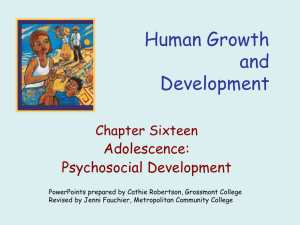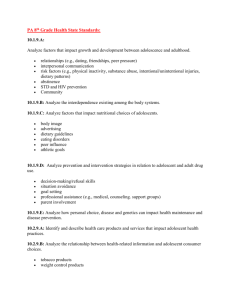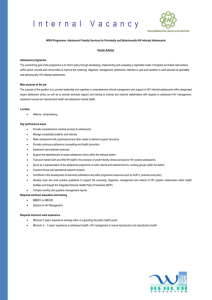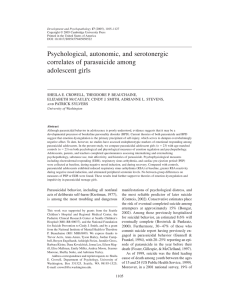Chapter 16 – Adolescence: Psychosocial Development Identity
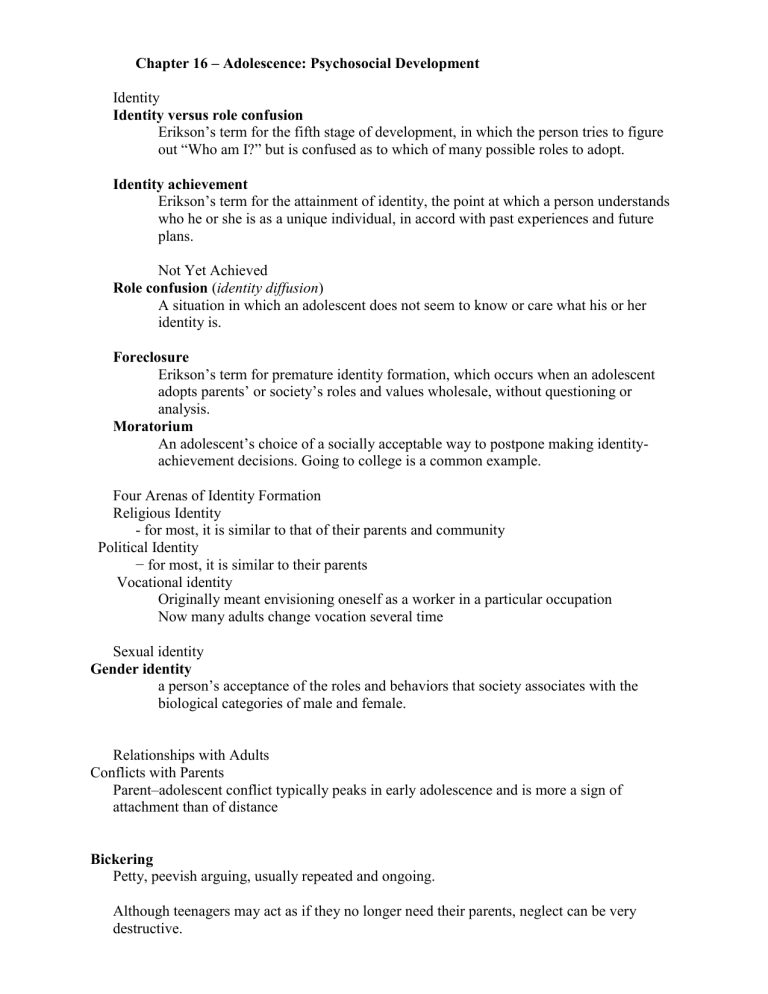
Chapter 16 – Adolescence: Psychosocial Development
Identity
Identity versus role confusion
Erikson’s term for the fifth stage of development, in which the person tries to figure out “Who am I?” but is confused as to which of many possible roles to adopt.
Identity achievement
Erikson’s term for the attainment of identity, the point at which a person understands who he or she is as a unique individual, in accord with past experiences and future plans.
Not Yet Achieved
Role confusion ( identity diffusion )
A situation in which an adolescent does not seem to know or care what his or her identity is.
Foreclosure
Erikson’s term for premature identity formation, which occurs when an adolescent adopts parents’ or society’s roles and values wholesale, without questioning or analysis.
Moratorium
An adolescent’s choice of a socially acceptable way to postpone making identityachievement decisions. Going to college is a common example.
Four Arenas of Identity Formation
Religious Identity
- for most, it is similar to that of their parents and community
Political Identity
− for most, it is similar to their parents
Vocational identity
Originally meant envisioning oneself as a worker in a particular occupation
Now many adults change vocation several time
Sexual identity
Gender identity a person’s acceptance of the roles and behaviors that society associates with the biological categories of male and female.
Relationships with Adults
Conflicts with Parents
Parent–adolescent conflict typically peaks in early adolescence and is more a sign of attachment than of distance
Bickering
Petty, peevish arguing, usually repeated and ongoing.
Although teenagers may act as if they no longer need their parents, neglect can be very destructive.
Cultural Differences
Social construction: something, such as teen rebellion, that is common to only certain cultures.
In every culture, adolescents benefit from increasing autonomy but some cultures allow more
(i.e. U.S.) than others (i.e. Hong Kong)
Closeness Within the Family
Four Aspects of Closeness:
Communication: Do parents and teens talk openly with one another?
Support: Do they rely on one another?
Connectedness: How emotionally close are they?
Control: Do parents encourage or limit adolescent autonomy?
Parental monitoring
Parents’ ongoing awareness of what their children are doing, where, and with whom.
Positive consequences when part of a warm, supportive relationship
Negative when overly restrictive and controlling
Peer Power
Peer pressure
Encouragement to conform to one’s friends or contemporaries in behavior, dress, and attitude; usually considered a negative force, as when adolescent peers encourage one another to defy adult authority.
Deviancy training
Destructive peer support in which one person shows another how to rebel against authority or social norms.
Peer Pressure
Clique
A group of adolescents made up of close friends who are loyal to one another while excluding outsiders.
Crowd
A larger group of adolescents who have something in common but who are not necessarily friends.
Selecting Friends
Selection
Teenagers select friends whose values and interests they share, abandoning friends who follow other paths.
Facilitation
Peers facilitate both destructive (“Let’s all skip school”) and constructive (“Let’s study together”) behaviors in one another.
Helps individuals do things that they would be unlikely to do on their own.
Romance
Sequence of male–female relationships during childhood and adolescence:
1. Groups of friends, exclusively one sex or the other
2. A loose association of girls and boys, with public interactions within a crowd
3. Small mixed-sex groups of the advanced members of the crowd
4. Formation of couples, with private intimacies
Culture affects timing and manifestation of each step.
Same-Sex Romances
Sexual orientation
Whether a person is sexually attracted to others of the same sex, the opposite sex, or both sexes
Gender identity disorder
According to the DSM-IV where one may not identify with their biological sex.
Some believe this should be omitted from the DSM-V as it may originate in society and not in the individual.
Learning About Sex
Learning From Peers
Adolescent sexual behavior is strongly influenced by peers.
Specifics of peer education depend on the group: All members of a clique may be virgins, or all may be sexually active.
Only about half of U.S. adolescent couples discuss issues such as pregnancy and STIs before becoming sexually active.
Learning From Parents
Parents often underestimate their adolescent’s need for information.
Many parents know little about their adolescents’ sexual activity and wait to talk about sex until their child is already in a romantic relationship.
Learning in School
Most parents want other adults to provide up-to-date sex education.
Sex-education policies vary dramatically by nation.
Abstinence-only programs are controversial.
Crucial test of sex education is not if adolescents can learn facts but if their knowledge affects their behavior
Depression
A dip in self-esteem at puberty is found for children of every ethnicity and gender
Clinical depression
Feelings of hopelessness, lethargy, and worthlessness that last two weeks or more.
Rumination
Repeatedly thinking and talking about past experiences; can contribute to depression and is more common in girls.
Suicide
Suicidal ideation
Thinking about suicide, usually with some serious emotional and intellectual or cognitive overtones.
Adolescent suicidal ideation is common, completed suicides are not.
Adolescents are less likely to kill themselves than adults are.
Parasuicide
Any potentially lethal action against the self that does not result in death.
Parasuicide is common, completed suicide is not.
Internationally, rates range between 6 and 20 percent
More common in U.S. girls than boys
Gender Differences in Suicide
Suicide rate among male teenagers in the U.S. is four times higher than the rate for female teenagers.
Reasons for this difference:
Male culture that shames those who attempt suicide but fail
Methods: Males tend to shoot themselves; females swallow pills or hang themselves
Girls tend to ruminate while boys withdraw.
Suicide
Cluster suicides several suicides committed by members of a group within a brief period of time.
Suicide Rates
Wealth and education decrease the incidence of many disorders but not suicide.
Since 1990 rates have fallen, especially among those with wealth and education.
Delinquency and Disobedience
Increased anger during puberty is normal but most adolescents express their anger in acceptable ways.
Life-course-persistent offender
A person whose criminal activity typically begins in early adolescence and continues throughout life; a career criminal
Adolescence-limited offender
A person whose criminal activity stops by age 21
Drug Use and Abuse
Variations in Drug Use
Drug use becomes widespread from age 10 to 25 and then decreases
Drug use before age 18 is the best predictor of later drug abuse
Variations by Place
Nations have markedly different rates of adolescent drug use, even nations with common boundaries.
These variations are partly due to differing laws the world over.
Drug Use and Abuse
Variations by Generation and Gender
Most adolescent drug use has decreased in the U.S. since 1976 but synthetic narcotic and prescription drug usage is up.
Gender differences reinforced by social constructions about proper male and female behavior
(e.g., “If I don’t smoke, I’m not a real man”).
−Boys tend to take more drugs more often than girls
Most U.S. adolescents are not regular drug users and about 20% never use any drugs.
Rates vary from state to state.
Harm From Drugs
Tobacco
Slows down growth (impairs digestion, nutrition, and appetite)
Reduces the appetite
Can damage developing hearts, lungs, brains, and reproductive systems
Alcohol
Most frequently abused drug among North Americans
Heavy drinking may permanently impair memory and self-control by damaging the hippocampus and prefrontal cortex.
Alcohol allows momentary denial of problems
when ignored problems get worse, more alcohol is needed
Denial can have serious consequences
Harm From Drugs
Marijuana
Adolescents who regularly smoke marijuana are more likely to drop out of school, become teenage parents, and be unemployed.
Marijuana affects memory, language proficiency, and motivation.
Preventing Drug Abuse: What Works?
Drug use is progressive and first use is usually social
Few adolescent drug users are addicts but occasional use can lead to addiction.
The younger a person is when beginning drug use, the more likely addiction will occur.
Occasional drug use excites the limbic system and interferes with the prefrontal cortex
drug users are more emotional and less reflective.
Preventing Drug Abuse: What Works?
Generational Forgetting
The idea that each new generation forgets what the previous generation learned. As used here, the term refers to knowledge about the harm drugs can do.
Massive Ad Campaigns
Have worked in FL and CA where teen smoking was cut by almost 50%
Changing the Social Context
Higher prices, targeted warnings, better law enforcement has cut down smoking
Preventing Drug Abuse: What Works?
Scare tactics may increase drug use because:
1.
The advertisements make drugs seem exciting
2.
Adolescents recognize the exaggeration
3.
the ads give some teenagers ideas about ways to show defiance








